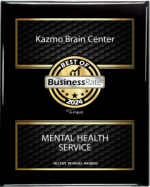Are you aware of how mental health affects your physical health? Mental health is essential to overall well-being and plays a significant role in how our bodies function. In this blog, we’ll explore how mental health can impact physical health and the steps we can take to ensure both are given the attention they need for optimal well-being.
The Connection Between Mental and Physical Health
To understand why mental and physical health is so intertwined, remember that the distinction between the two is less important than we might think. Though our thoughts, moods, and mental state may appear abstract or separate from the physical, they are all part of our brain activity.
What Effects Does Physical Health Have on Mental Health?
Changes in dopamine, a “happiness hormone” associated with motivation and reward, are one of the most well-established effects on mental health. Estrogen inhibits dopamine transmission. So when estrogen levels rise, as they do just before ovulation and again just before your period, your dopamine levels fall.2 This can exacerbate symptoms in people with ADHD. However, for people suffering from bipolar disorder or other psychosis conditions, this can alleviate psychosis symptoms.
Meanwhile, as progesterone levels rise in the second half of your cycle, so do allopregnanolone levels, a neurosteroid that, in high doses, can act as an antidepressant, anti-anxiety, and pain reliever but, paradoxically, causes increased anxiety, irritability, and other negative mood symptoms. This perplexing effect is most noticeable when progesterone levels plummet in the final days before your period begins. It contributes to PMS mood changes.
According to research, interaction is a two-way street. Diabetes, hypertension, or even prolonged periods of poor nutrition can cause stress-induced changes in the brain, leading to mood and neurodevelopmental disorders. Similarly, mood and neurodevelopmental disorders can cause stress, which causes metabolic changes that, over time, can lead to the same metabolic diseases.
How Does Mental Health Affect Physical Health?
Several studies have found that mental illness may hasten biological aging, manifesting as increased cardiovascular disease, age-related diseases, and life expectancy of up to 10-20 years.
However, there is much more to aging than just DNA methylation. So think of your epigenetic clock as a risk factor or predictor, similar to how a person with a genetic predisposition to breast cancer is at higher risk but not guaranteed to get cancer.
According to the findings, psychological stress associated with many mental illnesses may be linked to premature aging in several ways:
- Stress can lead to unhealthy behaviors such as poor diet, lack of exercise, and substance abuse, all detrimental to physical health.
- Stress can disrupt sleep, harming physical health over time.
- Chronically elevated cortisol levels caused by stress can disrupt nearly every bodily function, including the digestive, immune, cardiovascular, and reproductive systems.
This can put people with mental illnesses at risk for a variety of chronic conditions, including:
- Hypertension (high blood pressure)
- Heart Disease
- Diabetes
- Stroke Insomnia
Tips for Keeping Your Mental and Physical Health
The research on the interactions between mental and physical health has a silver lining: it demonstrates that the body and brain are extremely responsive to change.
That adaptability is partly responsible for the snowball effect of any current mental and physical health symptoms. However, this adaptability will allow anything you do to take care of yourself to have the same power to cause a snowball effect of positive changes in your body. Here are a few places to start.
Consume a Well-Balanced Diet.
Drink plenty of water. The general recommendation is three to four liters per day.12 Do not be concerned about alkalinity or electrolytes. You can hydrate yourself with any safe drinking water.
Consume more fruits and vegetables. The recommended five servings per day amount to about 12 to 2 pounds.13 Don’t overthink it; any fresh produce is good for you. Just make sure there isn’t a lot of added sugar or salt in canned or frozen options.
Be wary of processed foods. Even minimally processed and ready-to-eat foods, such as bread or soup, can have a surprising amount of salt and sugar. If you have these ready-made options, look for low-sodium, low-sugar alternatives on the label.
Make regular exercise a habit for life.
Follow these guidelines for the best short- and long-term results:
Don’t go overboard. Stress and injury from intense training can undermine exercise’s physical and mental benefits.
Aim for 150-300 minutes of moderate aerobic physical activity per week, with at least two days of muscle-strengthening activities.
Choose activities that you enjoy. Exercise does not have to be about peak performance or getting the most out of each workout. It simply has to get your body moving and perhaps challenge you when you have the energy to do so. Hike, swim, dance, play with your dog, go for a walk, whatever gets you moving without making you feel guilty. If you don’t know what you like, try something new every week until you do.
Begin with ridiculously small objectives. Putting simple daily goals in place will prevent you from quitting before you become accustomed to exercising. Set the goal a little higher each week.
Make time to do nothing.
Many health advice, including the suggestions above, focuses on what you should do or change. Nevertheless, stress also plays a significant role in negative mental-physical interactions. So, as part of your healing process, make time not to be concerned about whether you’re eating the right foods, exercising enough, or being productive enough.
Simply sit down for a few minutes each day with no TV, phone, or other distractions and just be. Take note of where you are and how you are feeling right now. That’s all. Don’t think about what comes next or what you should be feeling or doing right now. Just be there for a few minutes, or 40-45 minutes if you have the time.







